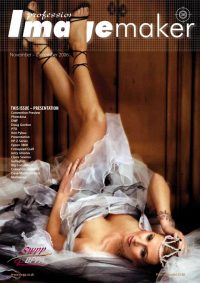articles/Business/areyouwellpresented-page12
Are You Well Presented? - part 12 of 1 2 3 4 5 6 7 8 9 10 11 12 13
by Tom Lee Published 01/11/2006
Keeping in Contact - making proofs
Contact sheets are a good way to provide your client with a preview of the files that you have available from a shoot, be it a wedding or a commercial job. Assuming that the job is small, ie not many images and delivered on CD/DVD then a contact sheet is ideal, and Adobe Bridge is probably the best way to create one. From within Bridge, select the files you wish to send for review/approval by clicking and Ctrl-clicking. Note immediately that you have access to all image formats including your RAW files, a significant advantage over many other methods.
Then click Tools>Photoshop>Contact Sheet II from within Bridge. Now choose the image size you require to fit your jewel case. These are nominally 12cm square but check yours before you start. We chose smaller than 12x12 so that we could drag the finished contact sheet onto a pre-prepared background containing content details, contacts and company logos. Ideally you should repeat this information on the body of the CD/DVD - when these things get into a commercial organisation they get taken to meetings and left behind in the CD slot of the conference room computer, never to be seen again!
When you print your jewel case slip-in, set the Photoshop driver to add crop marks so that you can trim for a really neat presentation, it all helps to keep things looking professional.
For the larger proof set
For a variety of reasons you may choose not to provide your client with electronic proofs or a slideshow. Assuming that you have to provide some form of images for approval or selection, your other option is to provide 'proofs'. These can take the form of a bound, small-size proof album (for social pictures), ring-bound A4 sheets with a cover for commercial work (binding saves the images getting lost, mixed up or detached from the contact details - your work may be reviewed along with that of other photographers. Some wedding photographers provide proofs in a neat box. Regardless of how you do it, the most important thing is that the client and photographer should be able to identify the image by its filename.
There is a break-even point for the creation of proofs. Suppose that you take 800 frames at a wedding (not uncommon these days). If you were to decide to make 6x4 inch proofs by inkjet then you are looking at about £80 in consumables (assuming 10p per 6x4) and about five to six hours of printing and trimming. This does not allow time for collating and sorting the prints! Assuming that this prospect has scared you into more modest proofing ambitions, here are your options for improving your workflow.
Firstly you should scale back the individual size and then, to reduce the amount of trimming, place multiple images onto either A4 or A3 sheets. This may be done by the process described above for CD slip-ins but remember, even at 10-up on an A4 you are still going to have to make 80 sheets from our notional 800-shot wedding. If you employ an Epson 4800 to make the proofs then you can use the sheet feed tray, which can handle thinner 'proofing quality' papers to allow the job to proceed without intervention.
If nothing else, the discussion above should cause you to think hard about your workflow! It makes you realise why some photographers take lots of shots but only show their client those that they, the photographer, have chosen. The downside of this approach is the loss of potential sales - your shotof Aunty Aggie might be technically awful but if it was the last one before she died on the way home (it does happen!) it suddenly becomes important to the client. It seems that there are as many approaches as there are photographers - the only thing is to sit down, work out the workflow, time it realistically and then ask if your fees represent a good return on your investment of time. Your conclusion could be that which many photographers have reached: it is still easier to let your processing laboratory take the strain! One thing is quite sure, if you work harder to make every shot count and come back with a smaller total number of better quality shots then you will save time and money at every stage downstream from the wedding.
Please Note:
There is more than one page for this Article.
You are currently on page 12
- Are You Well Presented? page 1
- Are You Well Presented? page 2
- Are You Well Presented? page 3
- Are You Well Presented? page 4
- Are You Well Presented? page 5
- Are You Well Presented? page 6
- Are You Well Presented? page 7
- Are You Well Presented? page 8
- Are You Well Presented? page 9
- Are You Well Presented? page 10
- Are You Well Presented? page 11
- Are You Well Presented? page 12
- Are You Well Presented? page 13
1st Published 01/11/2006
last update 09/12/2022 14:51:12
More Business Articles
There are 17 days to get ready for The Society of Photographers Convention and Trade Show at The Novotel London West, Hammersmith ...
which starts on Wednesday 14th January 2026





